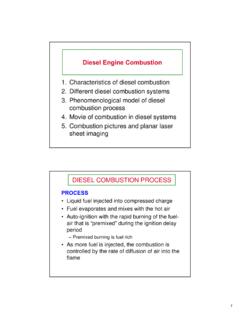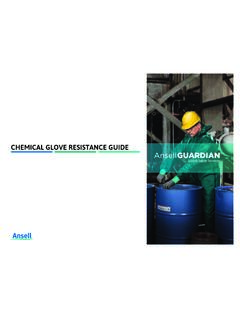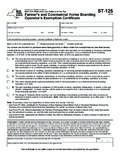Transcription of Diesel injection, ignition, and fuel air mixing
1 1 Diesel injection, ignition, and fuel air mixing1. Fuel spray phenomena2. Spontaneous ignition3. Effects of fuel jet and charge motion on mixing -controlled combustion4. Fuel injection hardware5. Challenges for Diesel combustionDIESEL FUEL INJECTIONThe fuel spray serves multiple purposes: Atomization Fuel distribution Fuel/air mixingTypical Diesel fuel injector Injection pressure: 1000 to 2200 bar 5 to 20 holes at ~ - mm diameter Drop size to 10 m For best torque, injection starts at about 20oBTDCI njection strategies for NOx control Late injection (inj. starts at around TDC) Other control strategies: Pilot and multiple injections, rate shaping, water emulsion2 Diesel Fuel Injection System(A Major cost of the Diesel engine) Performs fuel metering Provides high injection pressure Distributes fuel effectively Spray patterns, atomization etc.
2 Provides fluid kinetic energy for charge mixingTypical systems: Pump and distribution system (100 to 1500 bar) Common rail system (1000 to 1800 bar) Hydraulic pressure amplification Unit injectors (1000 to 2200 bar) Piezoelectric injectors (1800 bar) Electronically controlledEXAMPLE OF Diesel INJECTION(Hino K13C, 6 cylinder, L turbo-charged Diesel engine, rated at 294KW@2000 rpm) Injection pressure = 1400 bar; duration = 40oCA BSFC 200 g/KW-hr Fuel delivered per cylinder per injection at rated condition gm ~ cc (210 mm3) Averaged fuel flow rate during injection 64 mm3/ms 8 nozzle holes, at mm diameter Average exit velocity at nozzle ~253 m/s3 Typical physical quantities in nozzle flow Diesel fuel @ 100oC ~ , ~5x10-4N-s/m2 Nozzle diameter ~ mm L/d ~ 5 to 10 Reynolds No.
3 ~ 105 (turbulent) Pressure drop in nozzle~30 bar << driving pressure (~1000 bar) Injection velocitybar 1000 of P @ m/s 500 P2 ufuel uLdFuel Atomization Process Liquid break up governed by balance between aerodynamic force and surface tension Critical Webber number: Wb,critical~ 30; Diesel fuel surface tension ~ Typical Wbat nozzle outlet > Wb,critical; fuel shattered into droplets within ~ one nozzle diameter Droplet size distribution in spray depends on further droplet breakup, coalescence and evaporation du )(W Number Webber2gasb4 Droplet size distributionSize distribution:f(D)dD = probability of finding particle with diameter in the range of (D, D + dD) 0dD)D(f1Df(D)Average diameter 0dD D )D(fD 033dDD )D(fD )D(fdDdVV1 Volume distributionSauter Mean Diameter (SMD) 020332dDD )D(fdDD )D(fDDroplet Size DistributionFig.
4 Droplet size distribution measured well downstream; numbers on the curves are radial distances from jet axis. Nozzle opening pressure at 10 MPa; injection into air at 11 distance from jet centerline5 Droplet Behavior in Spray Small drops (~ micron size) follow gas stream; large ones do not Relaxation time d2 Evaporation time d2 Evaporation time small once charge is ignited Spray angle depends on nozzle geometry and gas density : tan( /2) gas liquid Spray penetration depends on injection momentum, mixing with charge air, and droplet evaporationSpray Penetration: vapor and liquid (Fig. 10-20)Shadowgraph image showing both liquid and vapor penetrationBack-lit image showing liquid-containing core050100mm050mm23 ms23 ms6 Auto-ignition ProcessPHYSICAL PROCESSES (Physical Delay) Drop atomization Evaporation Fuel vapor/air mixingCHEMICAL PROCESSES (Chemical Delay) Chain initiation Chain propagation Branching reactionsCETANE IMPROVERS Alkyl Nitrates by volume increases CN by ~10 Mixture cooling from heat of vaporization10-210-11 , Fuel equilvalence ratio of mixture0 255075100 125 Temperature drop (k)Adiabatic, constant pressure evaporation Dodecane in air Initial condition:Air at 800 K, 80 barLiq.
5 Dodecane at 350K, 80 bar 7 Ignition Mechanism: similar to SI engine knockCHAIN BRANCHING EXPLOSIONC hemical reactions lead to increasing number of radicals, which leads to rapidly increasing reaction ratesetc. ,ORORnPropagatio ChainOHRORHI nitiation Chain2222 2222 OHOCROCHORHOORROOHB ranching DegenerateORCHORORRROOHRHORA gents Branching of Formation Cetane Rating(Procedure is similar to Octane Rating for SI Engine; for details, of text)Primary Reference Fuels: Normal cetane (C16H34): CN = 100 Hepta-Methyl-Nonane (HMN; C16H34): CN = 15(2-2-4-4-6-8-8 Heptamethylnonane)Rating: Operate CFR engine at 900 rpm with fuel Injection at 13oBTC Adjust compression ratio until ignition at TDC Replace fuel by reference fuel blend and change blend proportion to get same ignition point CN = % n-cetane + x % HMN8 Ignition DelayIgnition delays measured in a small four-stroke cycle DI Diesel engine with rc= , as a function of load at 1980 rpm, at various cetane number(Fig.)
6 10-36)Fuel effects on Cetane Number (Fig. 10-40)Adding less stable speciesAdding more stable species9 Difficulty: do not know local conditions (species concentration and temperature) to apply kinetics informationTwo practical approaches: Use an instantaneous delay expression (T,P) = P-nexp(-EA/ T)and solve ignition delay ( id) from Use empirical correlation of idbased on T, P at an appropriate charge condition; Eq. ( of text)Ignition Delay Calculations idsitsitdt))t(P),t(T(11 ) )bar( ())171901)K(TR~1(Eexp))s/m( ()CA(EA(Joules per mole) = 618,840 / (CN+25) Diesel Engine CombustionAir Fuel mixing Process Importance of air utilization Smoke-limit A/F ~ 20 Fuel jet momentum / wall interaction has a larger influence on the early part of the combustion process Charge motion impacts the later part of the combustion process (after end-of-injection)CHARGE MOTION CONTROL Intake created motion: swirl, etc.
7 Not effective for low speed large engine Piston created motion - squish10 Interaction of fuel jet and the chamber wallSketches of outer vapor boundary of Diesel fuel spray from 12 successive frames ( ms apart) of high-speed shadowgraph movie. Injection pressure at 60 10-21 Interaction of fuel jet with air swirlSchematic of fuel jet air swirl interaction; is the fuel equivalence ratio distributionFig. 10-2211 Rate of Heat Release in Diesel Combustion(Fig. of Text)Part of combustion affected most by the charge motionDIESEL FUEL INJECTION HARDWARE High pressure system precision parts for flow control Fast action high power movementsExpensive system12 FUEL METERING AND INJECTION SYSTEM -CONCEPTP lungerFuel inFuel spillFuel injectionProcess.
8 Fill Pressurize Inject SpillFuel Delivery ControlFrom Diesel Fuel Injection, Robert Bosch GmbH, 199413 Fuel Rack and In-line PumpFrom Diesel Fuel Injection, Robert Bosch GmbH, 1994 Distributor pumpDiesel Injector14 Electronic Unit InjectorSAE Paper 891001 Injection pressure Positive displacement injection system Injection pressure adjusted to accommodate plunger motion Injection pressure rpm2 Injection characteristics speed dependent Injection pressure too high at high rpm Injection pressure too low at low rpm15 Common Rail Fuel Injection SystemSAE Paper 1999-01-0833 Common Rail InjectorFrom Bosch: Diesel Engine ManagementNozzle opening speed controlled by the flow rate difference between the Bleed (6) and Feed (7) orifices16 Caterpillar Hydraulic Electronic Unit Injector (HEUI)SAE Papers 930270, 930271 Fuel line: 200kPa; Low pressure oil: 300 kPa;High pressure oil: up to 23 MPa;Intensifier area ratio 7:1 Injection pressure up to 150 MPaPiezoelectric injectorsNozzle moduleControl valveCoupling modulePiezo actuator module For both Diesel and GDI applications Up to 180 MPa injection pressure 5 injections per cycle In vehicle production already Suppliers: Bosch; Delphi; Denso; Siemens.
9 17 Split Injection (SAE Paper 940668)1600 rpm, 184 KPa manifold pressure, overall fuel equivalence ratio = ;50-50,3 stands for 50/50% split of fuel injection, with 3oCA spacing CHALLENGES IN Diesel COMBUSTIONH eavy duty Diesel Engines NOx emission Particulate emission Power density NoiseHigh Speed Passenger Car Diesel Engines All of the above, plus Fast burn rate18 Cavitation in Injection Nozzle Cavitation happens when local pressure is lower than the fluid vapor pressure Effects Affects the spray angle Damage to the nozzle passage Factors affecting cavitation Combustion chamber pressure Local streamline curvature within the nozzleFlow process that leads to cavitationCombustion chamber pressurePcfurther friction drop PfBernoulli drop Pb= f(u12-u22)= fu22 [ (A2/A1)2-1] Pinj[ (A2/A1)]
10 2-1]pressureu1u2 Flow separation(recirculation region)Flow reattachmentPmin Pc- Pb- PfCavitation occurs if Pmin fuel saturation pressure













